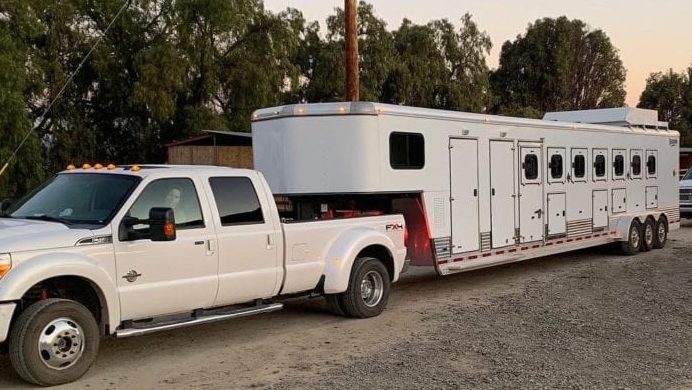Every DIY amateur knows the joys of hauling your own trailer. Some exhibitors have been hauling for years and are comfortable in almost any situation while others who are just starting may be thinking, “I have to drive that rig! What did I get myself into?”
Whatever your experience level, there is one aspect of hauling that can get to anyone…backing the trailer. Thankfully, GoHorseShow is here to help. Here are four phases that tend to occur when parking the trailer:
Phase 1: Where do I Park?
Horses have been put away, the trailer is unloaded, and you can’t put “it” off any longer. The dreadful task of parking the trailer, which you were trying to delay as long as possible, has arrived.
After finding the designated trailer parking area, you begin to scout for an open spot. Ideally, one that is big enough and can be easily pulled through; because honestly, who prefers backing the trailer? Unfortunately, we rarely get so lucky. When the “unicorn” spot is taken, you move on to the next best, the biggest spot you can find.
However, the condition of the parking spot should be considered too. AQHA Judge Ashley Hansen stresses the importance of picking a firm, dry spot to drop your trailer. She shared an almost mishap from her open show days, “Once, I backed into an area that was super sandy and I didn’t know. The jack almost broke because the trailer sunk in so much.”
Phase 2: Slight Panic
For the inexperienced hauler, the panic might hit right away as thoughts race through your head. Is anyone watching me? Maybe I overestimated my abilities. Which way do I turn again? First things first…breathe. Remember, you got the trailer here and you are capable of parking it too. Even if it takes a couple of attempts. Photographer and AQHA Amateur competitor, Amy Leibold shared, “I hate when I show up and have to back up in front of people. It’s so much pressure and I have to go ‘granny’ speed to get it right.”
Next, you need to plan. Depending on the size of your set-up, the parking spot, and potential obstacles, your approach will vary. If the space does not allow you to back straight into the spot, set yourself up for success by pulling the trailer so that it is straight. It will be easiest to maneuver the trailer when it begins in-line with your vehicle. Otherwise, you start from a position that needs to be corrected and can put you on the fast track to a jack-knifed trailer.
Phase 3: I Got This
You’ve found the parking spot and taken a few breathes to calm down, now you remind yourself, “I got this!” The most important rule of backing a trailer is remembering to think in opposites. For example, if you need the back of the trailer to go to the right, turn the wheel to the left and vice versa. One way to remember this is by steering the way you do not want the trailer to go.
Long-time DIY youth mom, Denise Ness recalls her struggle in learning this information. Ness says, “I had a horrible time remembering which way to turn the wheel. I would get it sometimes, but usually, my daughter got out of the truck to guide me and would just tell me which way to turn the wheel. Now if I come along to a show, I just let her drive.”
Another important thing to remember when backing a trailer is that a bumper pull takes longer to react than a gooseneck trailer. However, it will turn more sharply when it does begin to react. Keeping that in mind, you should begin turning your vehicle earlier but not as sharply as you might think. If you make the mistake of cranking the wheel right away, you will be correcting constantly and move in quite the zig-zagged line.
Phase 4: Wipe the Brow and Walk Away
At long last, the trailer is in its spot. Perhaps the journey was bumpy and came with some swearing, but you are ready to drop the trailer. With ease, you lower the trailer foot to the ground and release the hitch. After removing the vehicle’s load and checking everything over, you are ready to walk (or drive) away. Just be sure to unhook the lights and lower the tailgate before driving off. Now it is time to prepare for the next challenge, the horse show.








